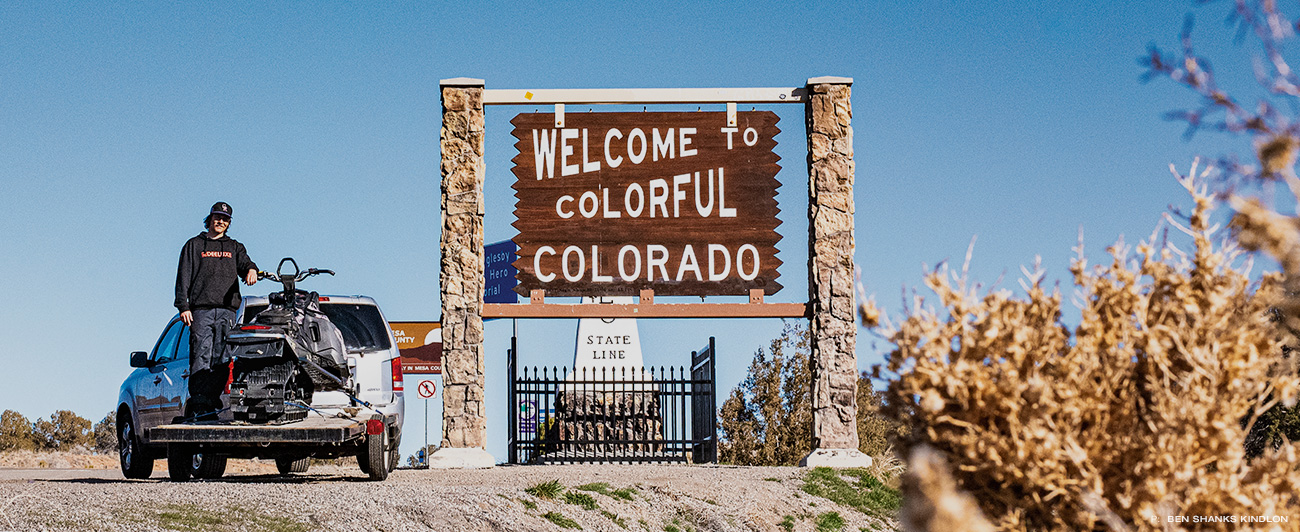Locale
You Know, ’Rado
Striking Gold in the Centennial State
First published in issue 20.1 of The Snowboarder’s Journal.
Ain’t it different?
When I first stepped in the game
Man tried leech on my name
Now they wanna act all distant
The sounds of London rappers Headie One, AJ Tracey and Stormzy reverberate through Grant Giller’s Honda Pilot as we drive from Ouray to Silverton on Colorado’s Million Dollar Highway. Hip-hop comes as a welcome respite from the European house music with which Grant unironically starts, fuels and ends most days. Admittedly, his tunes are charmingly hilarious and somewhat fitting considering we’re in an area known as the “Switzerland of America,” complete with picturesque 13,000-foot peaks sprawling for miles in almost every direction from this stretch of the San Juan Skyway. But regardless of how well the music matches the mountains, a temporary letup from 120 beats per minute is nice—something each of us will need every now and again during our 14-day fantastic voyage through the Centennial State.
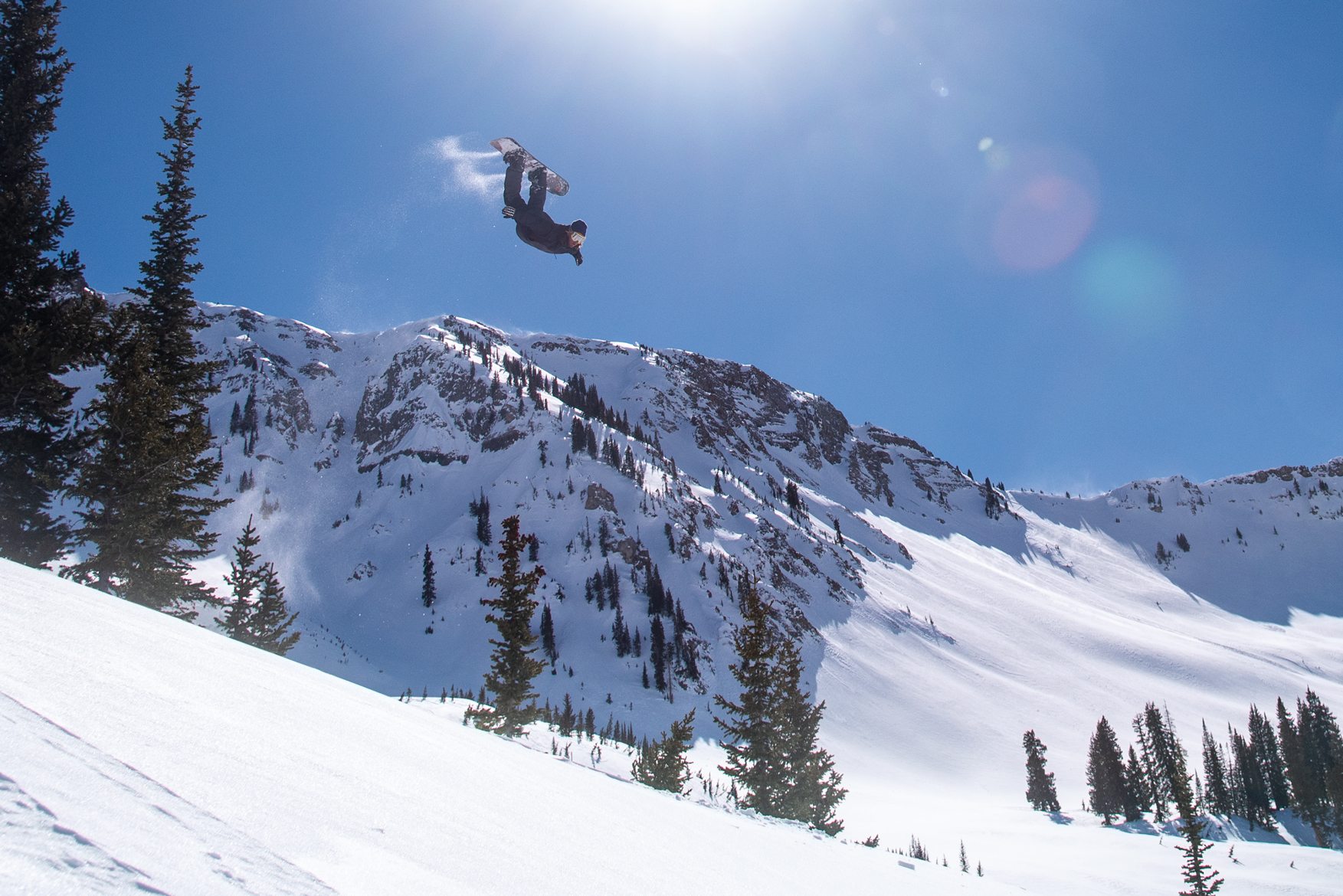
Classic Crested Butte, classic Tucker Andrews in the backcountry near the picturesque Wildflower Capital of Colorado. Photo: Grant Giller
When it comes to unlikely duos, Grant and I are truly dynamic. Off the mountain I spend a lot of my time in deep existential thought and roll rather slow, sometimes to a fault. Grant can go with the flow, too, so long as he knows exactly where that flow is going and when it’s arriving at wherever it leads to. He’s a go-getter, energetic and driven; a 28-year-old Cessna pilot who earns his buck by way of visual mapping when he’s not filming video parts or competing. Nonetheless we bonded through our mutual love for snowboarding at an event in 2018 and have been loosely planning this trip together ever since. Now that we’re here, I’m relieved we can connect on the British rap, too.
We’re freestyling things, with a general plan to snowboard several locations between the southeast border of Colorado and Breckenridge, linking up with various locals in their respective locales along the way. I’ve never snowboarded in Colorado before. Grant grew up in the town of Evergreen, not far from Golden, and is eager to show me around the land he affectionately calls home.
“I don’t get why Colorado gets such a bad rap,” Grant says as he maneuvers the skinny Skyway, which features no guardrail and heavy exposure on the passenger side. “There’s something for everyone here. So many people come to Colorado and have a great time, then they act all ironic about it.”
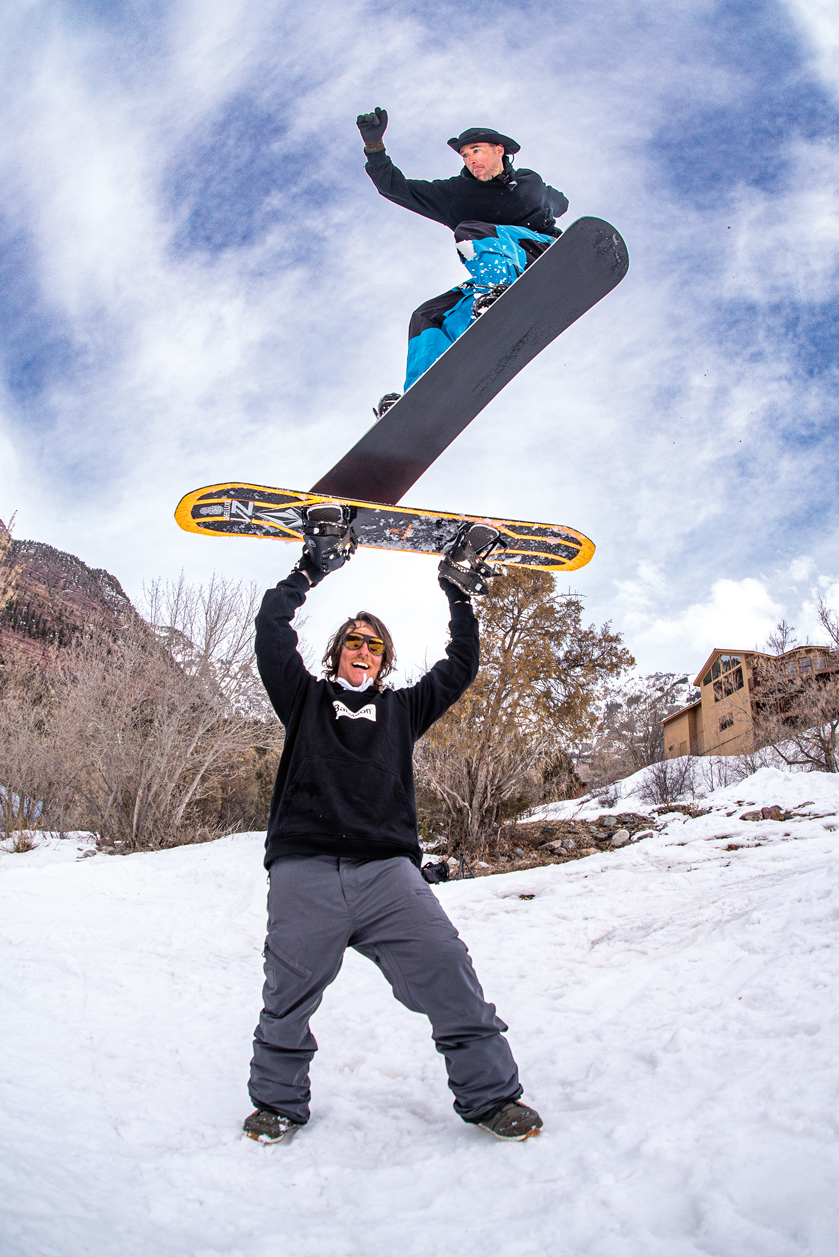
Shane Carrick over Grant Giller at Lee’s Ski Hill in Ouray. Lee’s is a community-run, publicly funded, free-to-ride ski area serviced by one rope tow. There’s only a couple hundred vertical feet of rideable terrain, but with the right crew there’s plenty of potential. Photo: Ben Shanks Kindlon
Twisting through the mountainside, our conversation shifts to the trending cultural distaste of Colorado that’s grown noticeably among the snowboard community, which, truthfully, I haven’t much understood either. Just before I left, I told a fellow cameraman that I was headed to Colorado and he replied, “Oh, I’m sorry.” When pressed lightly to explain himself, he laughed, shrugged, and said something like, “You know, ’Rado.’”
Hailing from New York, my earliest understanding of Colorado was that it’s a mecca of shred. White-bearded men on chairlifts across the Ice Coast would speak of their glory days “out west” at Telluride, Copper Mountain and other Colorado classics, whether you asked them to or not. Throughout the early 2000s, a plethora of park edits flowed from areas like Breckenridge, and Keystone’s once-iconic Area 51. In 2013 Burton moved the U.S. Open from Stratton, VT, to Vail. Ten-thousand-plus-foot peaks abound in Colorado; the snowfall is abundant in comparison to many rideable U.S. states. All of which begs the question: Why so much hate?
Surely the answer lies not solely with Colorado’s terrain, but rather the size of the crowds it attracts, as well as the demographics making up some of those crowds. The state saw a massive population boom throughout the 2010s, peaking with a nearly 100,000-person increase in 2015—one of the nation’s fastest-growing rates, according to the U.S. Census Bureau. With day tickets exceeding $200 at some Summit County resorts, it certainly ain’t cheap to board at certain resorts here either. But is it all heated sidewalks and overpriced parking? Does the song really suck, or is it a beautiful ballad that’s simply been overplayed and misappropriated?
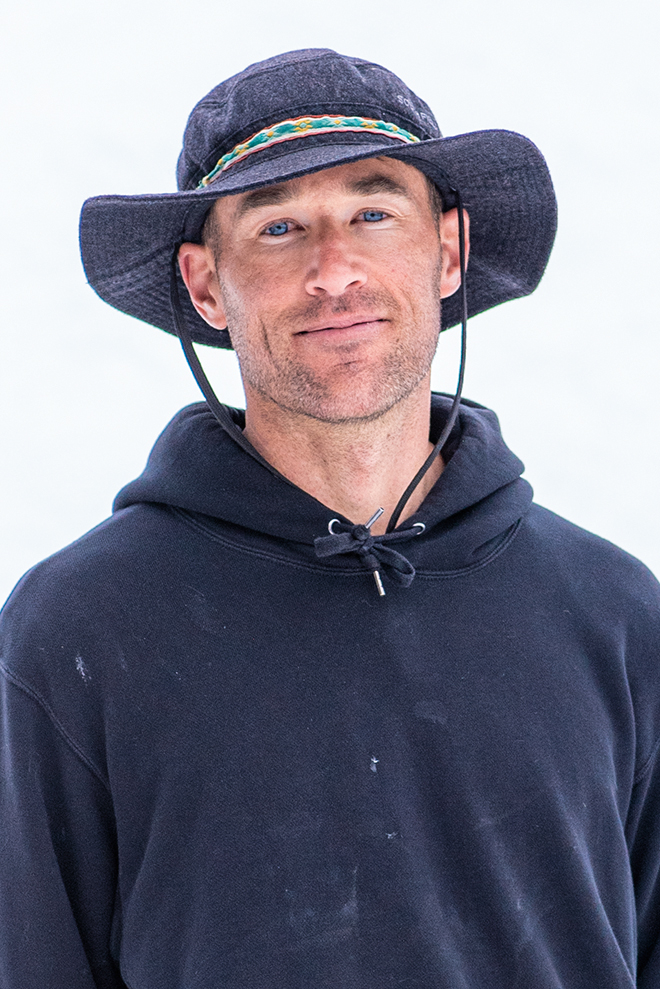
Ouray’s hometown hero, Shane Carrick. Photo: Ben Shanks Kindlon
It dawned on me that I’d allowed newer, negative stereotypes to deter me from ever riding Colorado. I needed to see the state for myself. Thus far, I’ve been liking what I’ve been looking at, and the people we’ve met during the first few days of the trip are amicable as can be. For the most part.
We started our morning by stoking a wood-fire stove in a cozy country cabin on the outskirts of Ouray, a quaint mountain municipality with a population just over 1,000. Our lodging came through a fortunate friend-of-a-friend hookup, which led Grant and me to meet local legend Shane Carrick. Shane, a 38-year-old skatepark builder with a surfy snowboard style, grew up a literal stone’s throw from Lee’s Ski Hill, Ouray’s free-to-ride rope tow servicing a couple hundred vertical feet of mellow terrain. Despite its diminutive size, Shane still rides there regularly. “My brother Devin and I used to tell people we lived in a ski-in, ski-out house,” Shane says, pointing to the house directly next to the bottom of the tow. Nowadays Shane lives several blocks away with his wife, Evie, and their daughter, Margot. Evie’s dad built the cabin we’re staying at—about a 20-minute drive from the town center—and despite having never known Grant or me prior to this week, the Carricks are hyped to host us.
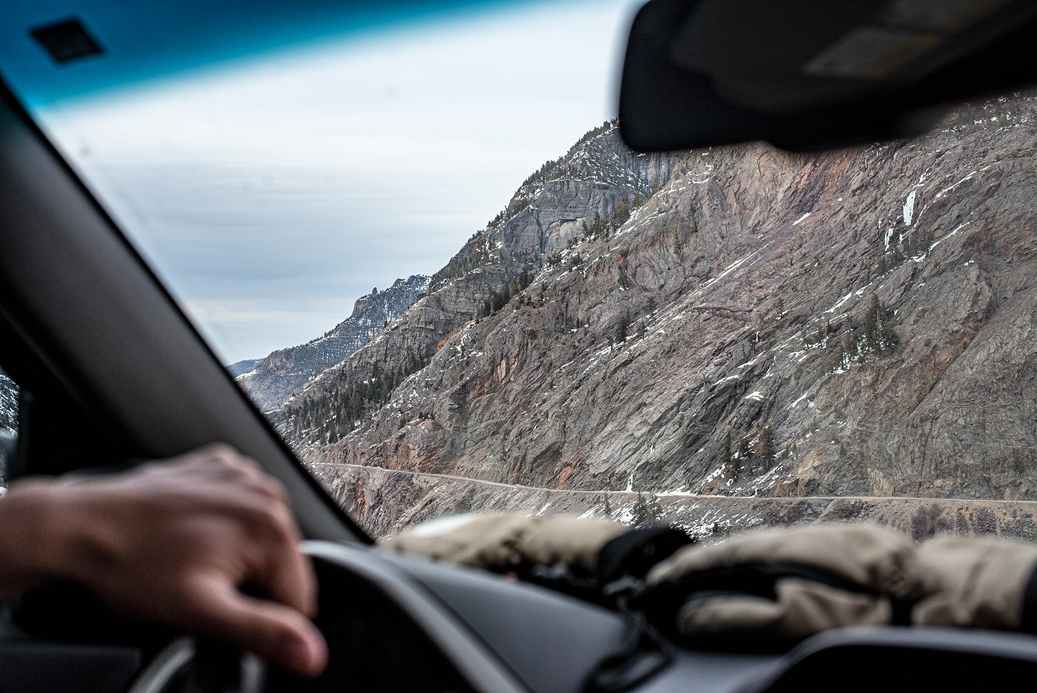
Driving along the Million Dollar Highway, which regularly makes Top 10 listicles of the “World’s Deadliest Roads.” Averaging 40 accidents and just under 10 fatalities per year, it’s earned the nickname “Highway to Hell.” Maneuvering these hairpin turns—which feature no guardrails—on an icier day would not be fun. Photo: Ben Shanks Kindlon
“You probably shouldn’t leave that there,” the man had told us. He came out of nowhere, dressed in blue jeans and a beige canvas jacket and looked to be in his early 60s. A friendly brown-and-white dog danced at his side as he motioned to the snowmobile and trailer we’d just unhitched from Grant’s rig. We’d planned to leave it on the road in front of the cabin as we explored Silverton for the day, but the man said it’d be in the way of heavy machinery that rolls up and down these gravel backroads. He graciously offered to let us store Grant’s rig in front of his house. His dog promptly ate the bagel I placed down on the snowbank. A fair trade. When we got to the house, the man was standing in his driveway with a handgun in his breast pocket. He helped store the sled, asked that we not leave it for too long, bid us adieu and strolled inside.
“Did you notice the gun when we first started talking to him?” Grant asked me once the man was out of earshot. I shook my head. “Me neither,” Grant said. I laughed, shrugged, then said something like, “You know, ’Rado.’” We are in the congressional third district, after all.
Ain’t it different?
Spent like 10 years grindin’
Covered in diamonds, never been mining
Came through, man’s still shining
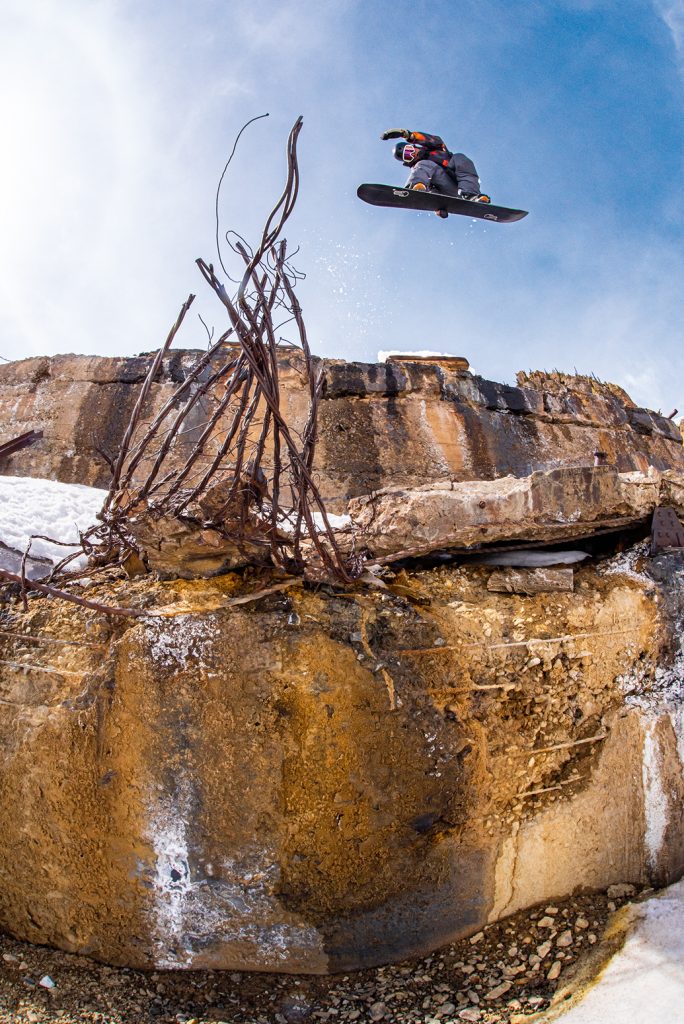
Grant Giller grabbing stale at an abandoned mine near Silverton. After the money dried up at this mine, its snowboarding value increased tenfold. Just be mindful of all the exposed rebar. Photo: Ben Shanks Kindlon
By the time we reach Silverton the sun is unforgiving. For mid-March, the snow is low-tide and slushy. We decide to explore Silverton’s numerous abandoned mines, of which there are plenty to choose from. Established in 1874, Silverton is a National Historic Landmark that saw a massive mining boom between the early 1880s and 1910s. The South Silverton mining area has produced ores of silver, gold, zinc, copper and lead collectively that is worth tens—if not hundreds—of millions of dollars. But in 1991 Silverton’s last major mine closed, and tourism has kept the town afloat ever since. You can still see remnants of the mining industry nearly everywhere you look, some of it preserved with tourism in mind.
Silverton is also a popular destination for boarders looking to ride well-known yet uncut, off-piste trails. We pass by a hoard of colorfully outfitted shredders loading a shuttle bus at Silverton Mountain, an operation that paints itself as a blend between New Zealand’s club fields and the state’s smaller ski areas. The mountain features over 1,800 acres of terrain, but only one lift to help you ascend partway up most of it—the rest relies on foot power, with the option to go guided or unguided. For a price more in line with riding the rest of the state’s resorts, you can opt for heli drops at Silverton, too.
But we’re keeping it low budget. After several hours exploring three abandoned mines, we still haven’t struck anything worth digging. Grant calls in another friend-of-a-friend and we learn about a mine with plenty of rideable options, which skier Bobby Brown had hit several seasons prior. Upon arrival, we start making our way uphill. Having lived at sea level for the past several seasons, the hiking here is hard—for me at least. “We’re only at 9,000 or so feet, dude,” Grant says with a laugh. Only?
I push through the dizzying heat and altitude. By the time I join Grant at the concrete vestiges of what was once a very lucrative mining structure, he’s already got his shovel in hand. He points out where we’ll need to avoid exposed rebar, we build out a few features, salt them and leave to let them freeze overnight. We return to ride them the following day, dance to house music in the parking lot, and then it’s back to our woodsy abode near Ouray. Next up: Red Mountain Pass.
White-bearded men on chairlifts across the Ice Coast would speak of their glory days “out west” at Telluride, Copper Mountain, and other Colorado classics, whether you asked them to or not.
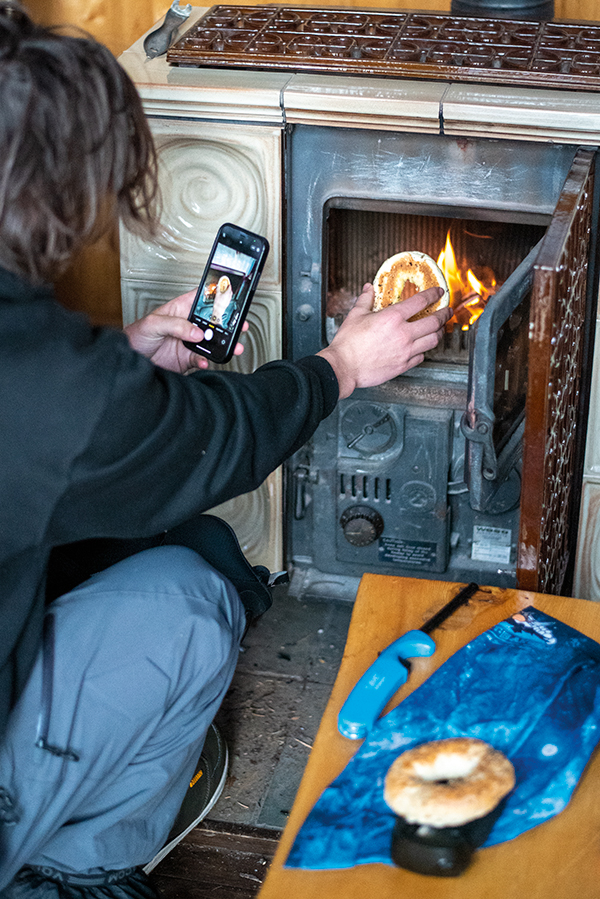
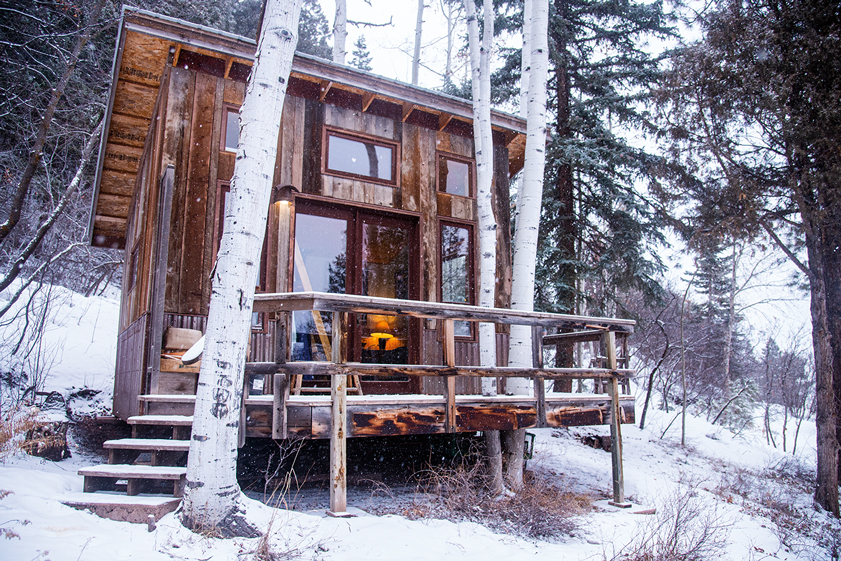
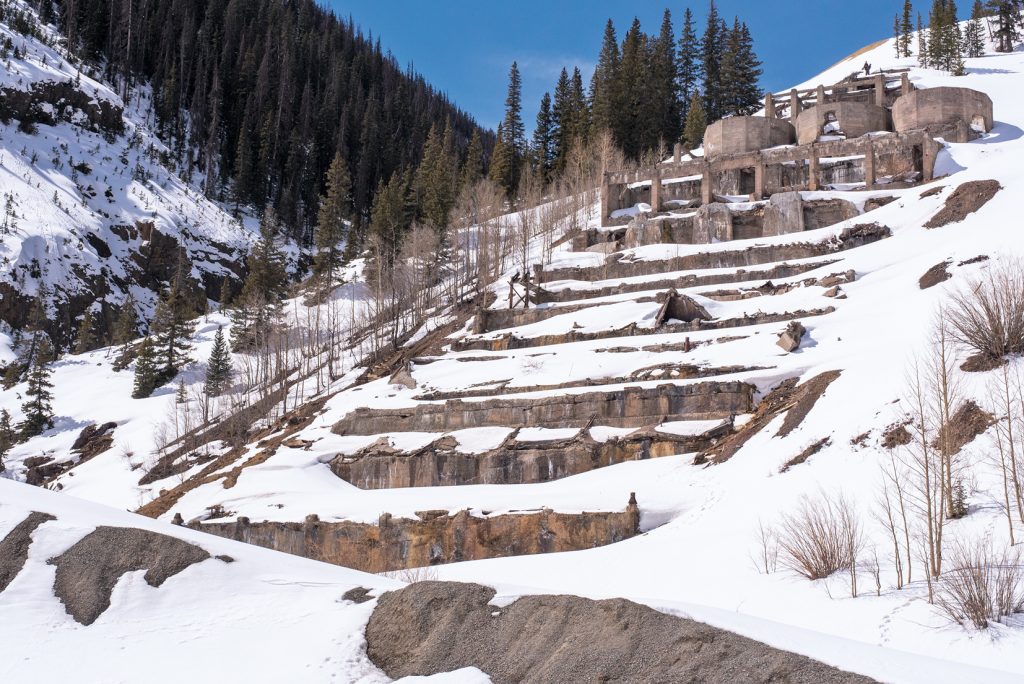
top to bottom
Grant filming a clip for one of his online cooking tutorials, I think.
The Carricks’ cabin on the outskirts of Ouray, where Grant and I stayed during the first leg of our trip. Building fires in the woodstove each morning and evening evolved from being seen as a chore to a welcome treat, but Grant never really came around to pooping in the outhouse. We can’t all be so brave, and that’s OK.
The South Silverton mining area is in the western part of Colorado’s San Juan Mountains. This spot feels like street riding in a backcountry setting. Shoveling for a janky cement ledge while wearing an avalanche beacon is weird, in a good way. Photos: Ben Shanks Kindlon
Situated between Ouray and Silverton, we’ve crossed over Red Mountain Pass a few times now. Grant motions to various roadside spots where he and friends have built stuff over the years. The options visible from the car seem limitless, and there’s plenty more beyond that.
We settle on a wavy windlip just minutes from the pavement. After putzing around on various aspects of the windlip and a casual drop nearby for a few hours, we return to Ouray for a slow, sunny session at Lee’s.
It’s a neighborhood affair. Parents of Ouray’s up-and-coming groms socialize at the base of the community hill while their kids take after-school hot laps. Between both snowboarders and skiers about a dozen of us are on-hill, and everyone becomes best friends. A few favor the bermed snake run that Shane and Devin dug out several weeks back, others frequent the side hits close to the tow, and nearly everyone takes their turn on the so-called “big air” jump—a shoulder-high kicker with a bumpy landing. “It’s so rad having this here,” Shane says as we ready to drop in on the all-ages kicker. “With a newborn I can’t make it up to the mountain as much, but with this here I can just drive across town and get some riding in.”
The following morning, we tidy the cabin and depart Ouray feeling like the odds have been in our favor. A collision in Crested Butte will bring that luck to a crashing halt.
Established in 1874, Silverton is a National Historic Landmark that saw a massive mining boom between the early 1880s and 1910s.
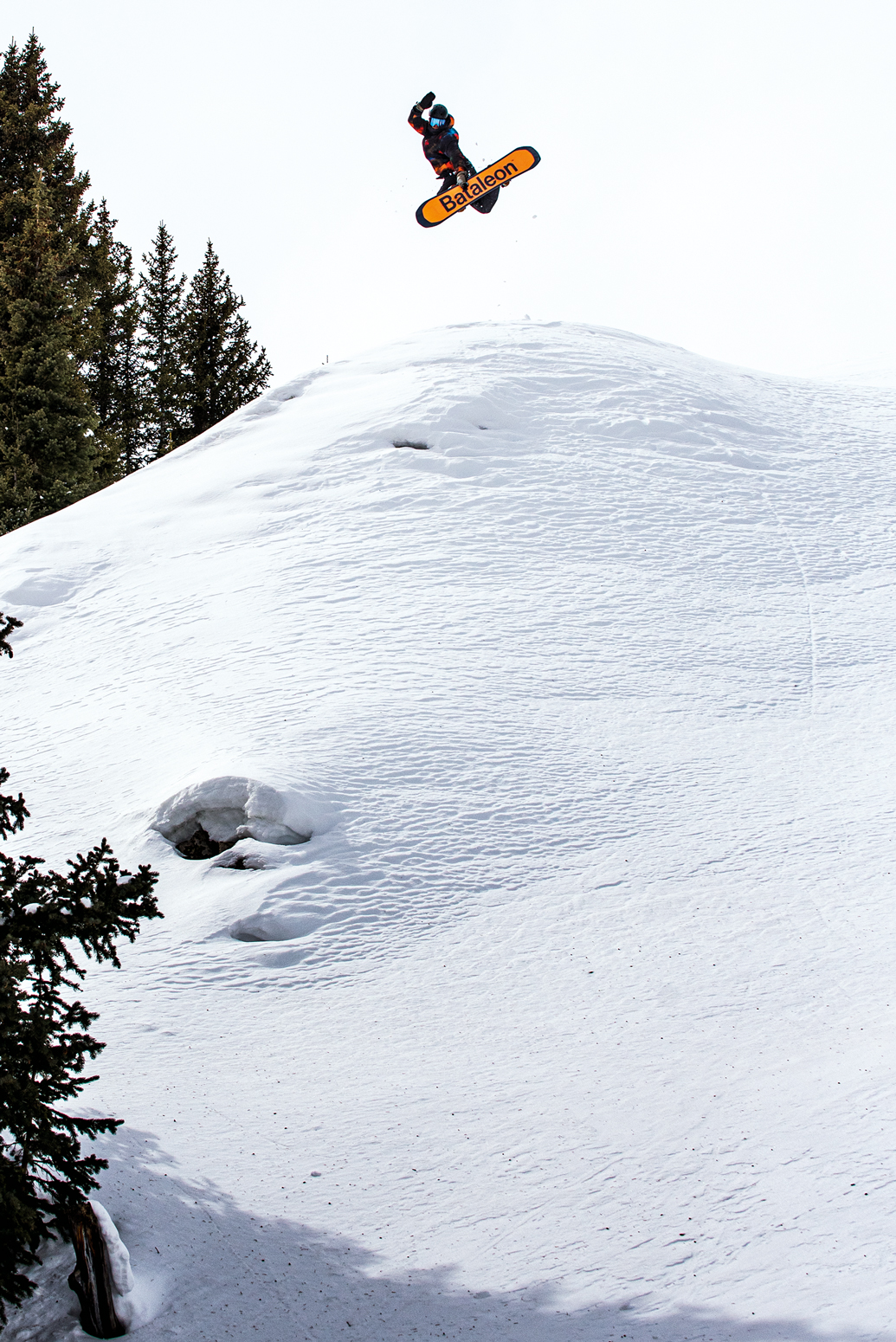
“10 years grindin’!”—Grant. “Never been mining!”—Me. Without radios, Grant and I took to yelling at each other before each hit in this zone on Red Mountain Pass. We were very close to the road, so it was difficult to make out the word “drop” over the sound of passing cars. Instead we chose to yell corresponding lyrics from the song “Ain’t It Different” to signal when we were both ready. Photo: Ben Shanks Kindlon
With its vast network of snowmobile trails and locals Tucker Andrews, Ari Lightsey, Josh Gallen and Andrew Buergin to guide us through them, we unload Grant’s sled and set off at 10 a.m. en route to a zone suitable for ample airtime. By about 10:10 I’m using a presumably separated shoulder to help Grant flip our snowmobile upright. We rally back to the car and then to Crested Butte Mountain Resort’s urgent care to confirm: acromioclavicular joint unrolled, grade three. C’est la vie.
I get slinged up and pass my camera off to the crew as they rally for round two. By afternoon of the following day, I receive word that Josh had to sled himself out of the jump zone with a hole in his bottom lip. Later we’d find out that he’d broken his jaw on impact with his knee on a 720 gone awry. One thing’s for sure: Crested Butte don’t play.
At 9,000 feet, negative-degree temps are normal here during winter but warm to the 20s by midday. I spend the next few days recovering, while the boys hop on the Mountain Express, a free public bus that’ll bring them directly from town to the lifts at Crested Butte Mountain Resort, one of countless ski areas recently acquired by Vail Resorts. The lift-accessed terrain is much gnarlier than you’ll find at many other resorts across the nation, but the steeps only line up every so often. By this time of the year the tide is low, but our crew makes the most of it.
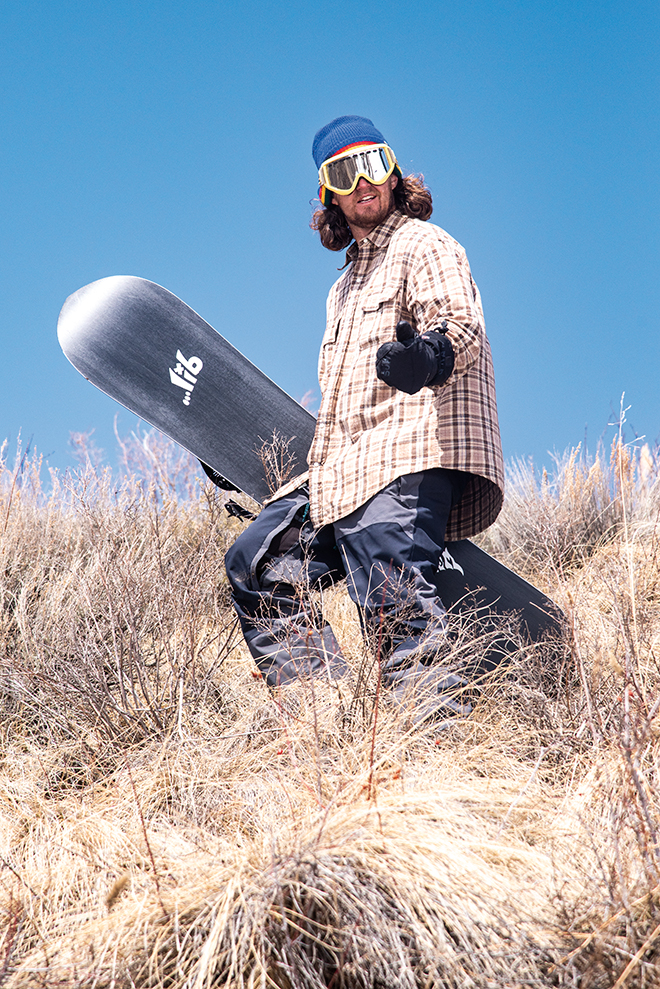
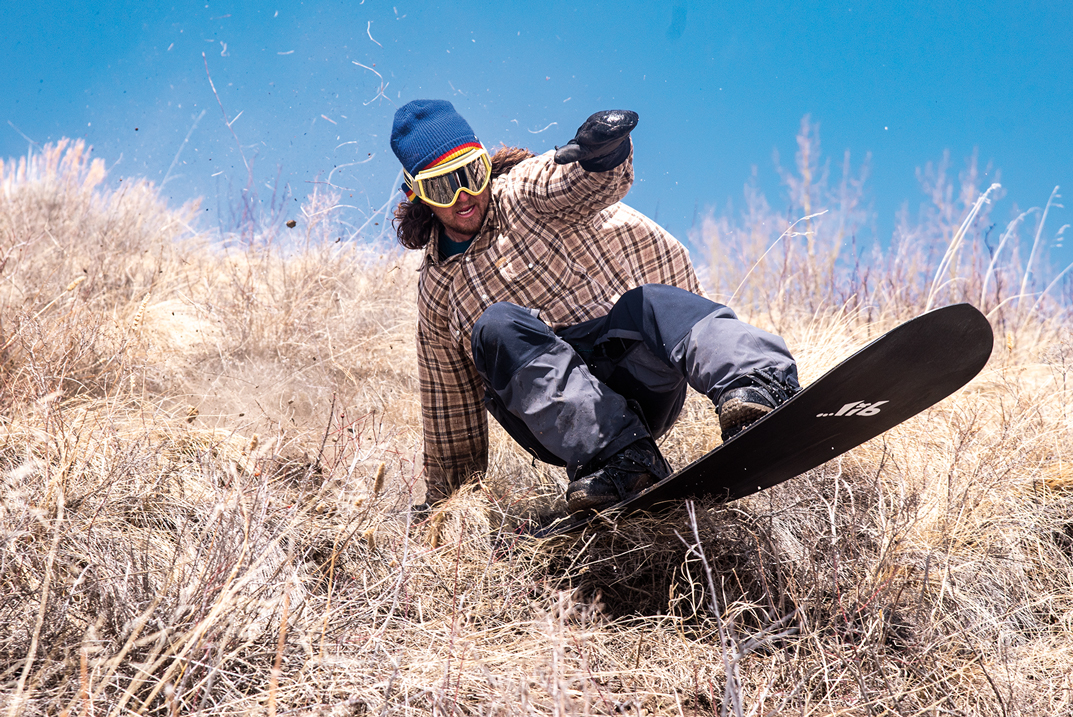
Tucker Andrews, low-tide hell ride at Crested Butte Mountain Resort. Photo: Ari Lightsey
Like Silverton and many of Colorado’s mountain towns, Crested Butte saw much of its early growth through mining—most typically hard rock, coal and steel in these parts. And like many of Colorado’s former mining towns, nowadays Crested Butte primarily serves as a recreation destination. Referred to as the “Wildflower Capital of Colorado,” Crested Butte’s coal-mining days are a thing of the past. The folks walking around the sunny, salty streets range from rough-edged, die-hard shredders who look to be getting by on a steady diet of Top Ramen and peanut butter, to high-end grocery-getters in Mercedes Benzes en route to their third homes. Despite their differences, people seem to coexist peacefully enough. Tucker tells me that depends on personal perspective.
“I grew up here and learned to snowboard here, and Crested Butte has always been this funky little hippie ski-bum town,” he says. “It still holds a taste of that, but it’s up for interpretation. If you haven’t left Crested Butte in a long time, you’d think it’s getting so crowded. I left for a decade and came back and think this is about as chill as it gets for a mountain town at this point. You can be jaded, but the growth is inevitable so it’s easier for me to not really dwell on that…It’s not going to stop, and you can’t be mad at people for wanting to come and experience this place. Some people visit just for the summer and end up staying for 10 years because it’s so awesome. You can’t be bummed on people for wanting a little piece of it.”
Ready for the bump and grind
Wheel it back and run it one more time
Yeah, yeah
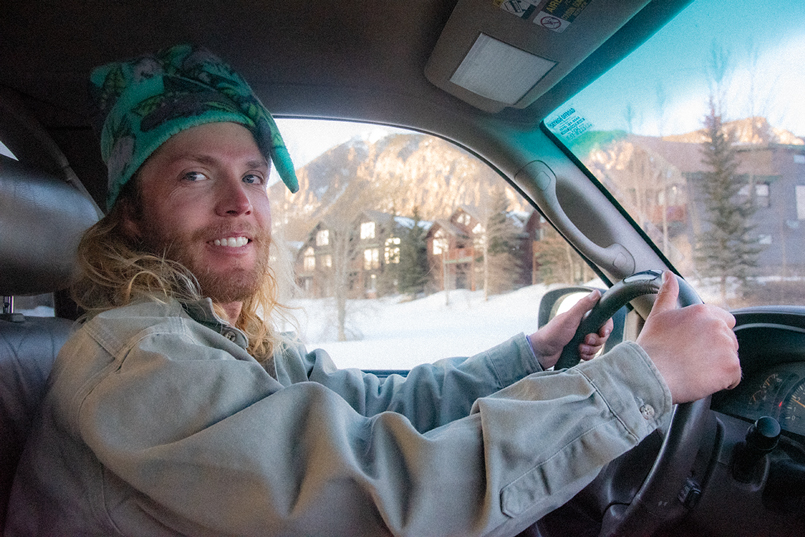
Ari Lightsey spends his summers fishing so that he can spend his winters snowboarding. Here he takes the wheel in search of more roadside hits around Crested Butte, cruising slowly alongside multimillion-dollar estates surrounding the mining-turned-mountain town. Photo: Ben Shanks Kindlon
We scratch Aspen from the itinerary and head from Crested Butte to Leadville for a quick semi-street mission near a mine that once produced zinc, gold and silver. Then we’re off to Breckenridge. From there, we rally to 11,990-foot Loveland Pass for the 11th annual Love Games, a DIY event hosted by Satellite Boardshop out of Boulder.
Over 100 people gather on the pass before slowly making their way to a hand-dug quarterpipe close to the road. Longtime residents like Chad Otterstrom and Kirk Teare session alongside fledgling talent eager to carry on Colorado’s core legacy. Event organizers lead the group from the QP to a hip called the Ironing Board. This end-of-season get-together is a look to the future and a nod to the past; 16-year-olds shoot to the moon on a jump that’s been built regularly for decades. As they fly overhead, I wonder if they realize they’re stomping on what was once ground zero for freestyle progression in snowboarding, home to legends such as Stevie Alters, Todd Richards, Jay Nelson, Russell Winfield, Mikey LeBlanc and Todd Franzen—to name a few.
“It’s a good history lesson for the kids,” Chad says. “Loveland Pass, along with a few others in Colorado, is where snowboarding started here. The resorts wouldn’t allow it, and you could run car laps on the passes. Also, in the early ’90s there was a huge blowup in the freestyle scene in Summit County. A lot of videos were filmed here, like Mack Dawg’s Pocahontas (1991) and Justin Hostynek’s pre-Absinthe Films Anthem from 1993.
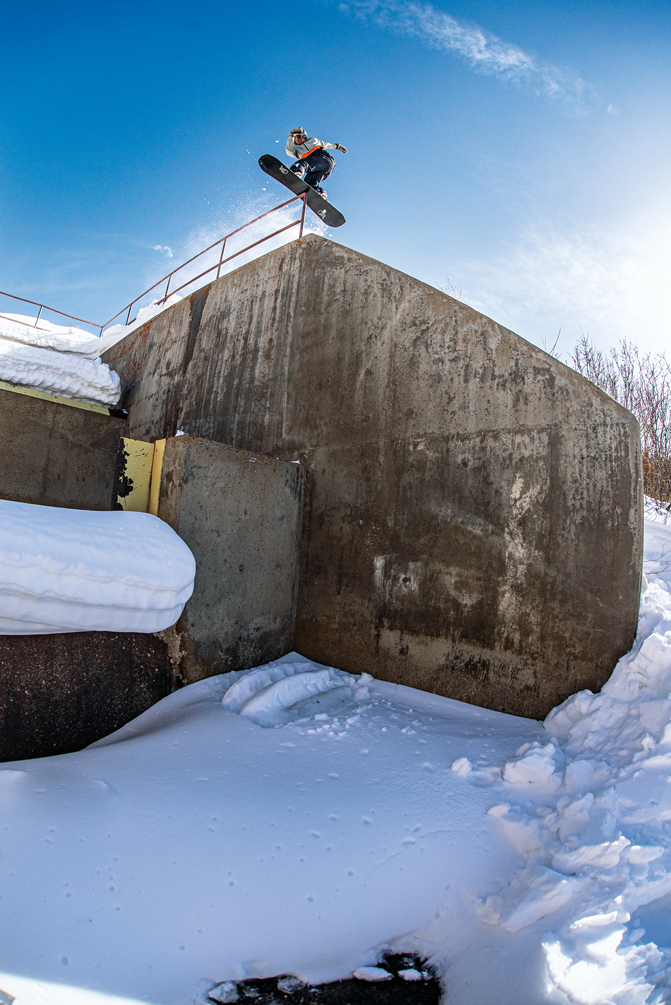
Grant Giller, frontside boardslide in Leadville, CO. Another one of those street spots without much street around. The landing of this feature led directly into a creek that was melting out extremely fast. Grant hit the buzzer beater just hours before it totally gave way to the stream. Photo: Ben Shanks Kindlon
“It’s cool to keep this tradition going every year. We got hosed with main events coming to Colorado and really blowing it out, and that’s all that people saw about Colorado—you know, see how hard you can spin off every park jump in town. We kind of lost our culture—well, we didn’t lose it, it’s still here. It just got lost in the media.”
We make our way from the Ironing Board to a line of small technical jumps. A group of friends carries a girl with an injured knee to each feature. Someone from Quebec gifts me a jar of CBD salve for my clipped wing, unprompted. Folks share snacks, stories, smoke and sunscreen with familiar faces and strangers alike.
The games wrap with a rail jam in a garden full of metal, wooden and PVC pipe features built and set by locals, which Grant tells me is free to hike and ride all season long. Admittedly, it pains me a bit to watch others sip my cup of tea, but, again, c’est la vie. For now, I’ll just have to add this little rail garden to my long list of reasons for return.
Don’t do drip but I still stay classy
You wanna know?
Then ask me,
easy
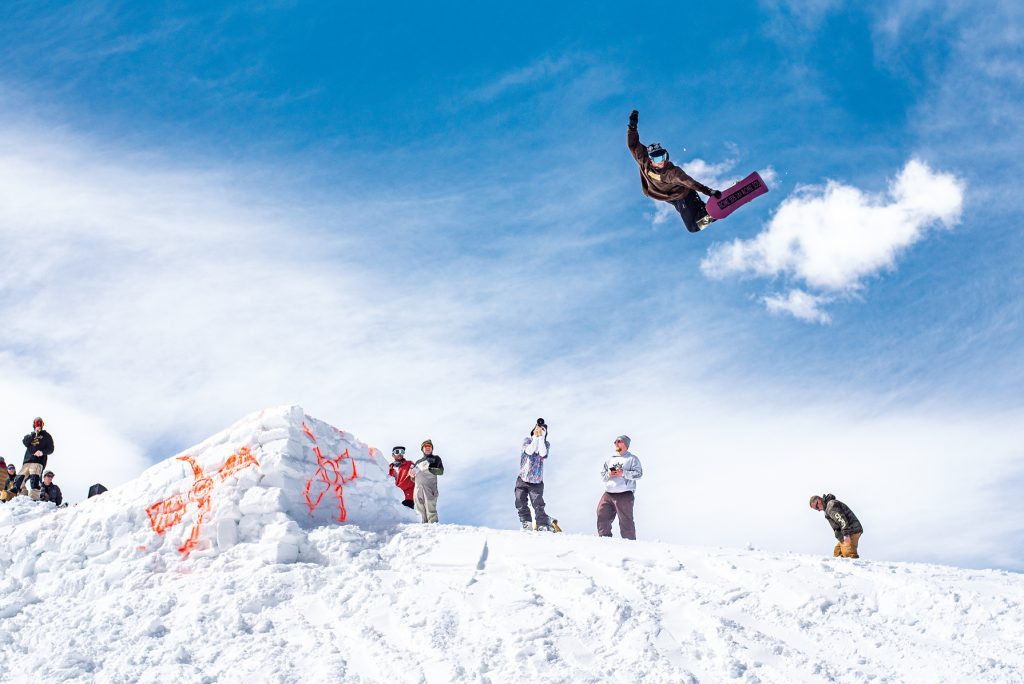
Kirk Teare, timeless trick on a popular jump: the Ironing Board at Loveland Pass, CO. This jump, along with a couple of other iconic features, come to life during the annual Love Games, a year-end gathering that pays homage to the Colorado-based forefathers of freestyle who regularly rode and filmed at Loveland and other mountain passes around Summit County. Photo: Ben Shanks Kindlon
Donning his purple Colorado Rockies hat, Grant limps to the car. Hundreds of miles and countless hours boarding have finally caught up to the colorful Coloradan. I crawl into the backseat and Grant’s girlfriend, Summer Fenton, takes the wheel to drive us east along I-70 from Breckenridge to the Denver airport. We collectively daydream about powder in the Aspen backcountry, inbounds laps at Copper Mountain, the free-to-ride Ruby Hill Rail Garden hike park in Denver, and all the other destinations we hadn’t had time to hit. Regardless of never reaching those spots, I’ll still have plenty of golden nuggets to rehash about my glory days in Colorado—anecdotal ammo to one day deliver through a weathered white beard to up-and-coming groms on the chairlift, whether they ask me to or not. As we cruise from the mountains into the Mile High City, Grant continues to point out spots with plenty of potential along the way.
“I’m proud of where I’m from,” he says. “I’m so proud of where I’m from, I’m about one step from getting a Colorado tattoo. There really is something for everyone here. And make note, I haven’t been giving away all of Colorado’s secrets—far from it.”
As they fly overhead, I wonder if they realize they’re stomping on what was once ground zero for freestyle progression in snowboarding
